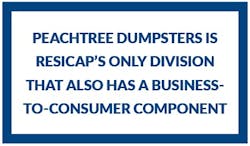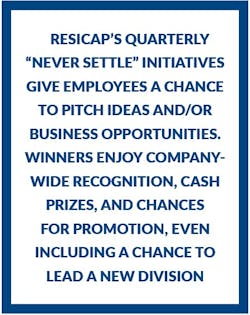Doing It All
The Great Recession put 8 million Americans out of a job, shuttered 2.5 million businesses, and forced 4 million homes into foreclosure. In a lot of ways, it also created ResiCap, a $450-plus million company that, apart from offering a myriad of services, has the resources and capability to simultaneously renovate hundreds of homes, across dozens of states, for multiple clients.
In the early years, the business was much different. “Flipping homes and taking advantage of the first-time homebuyer credit was our basic premise starting out,” says Andy Capps, co-founder of the company. He and co-founder Lance Popp were buying up properties with their own money to fix up and sell to hopeful new homebuyers. But in the aftermath of the downturn, no one was buying.
Finding Footing
From 2006 to 2010, annual home sales fell from just over 1 million to 323,000, according to U.S. Census data. “No one could get a mortgage,” Capps recalls. And so the company looked elsewhere for revenue.
The plan was always to lease, but there was really no interest in single-family homes at the time. Tighter lending standards and general fear kept people out of the market. As a result, the company looked overseas, where there were still buyers interested in single-family homes.
“We targeted markets that could take advantage of their currency’s value relative to the U.S. dollar,” he says. “Our strategy involved renovating, leasing, selling our assets with a 12-month rental guarantee, and maintaining the property management activities post sale.“
At one point, ResiCap was selling about 100 homes a month, Capps explains. “It allowed us to scale our operation to a size that didn’t exist in the single-family rental industry.”
It wasn’t until 2012, when the Federal Housing Finance Agency launched the Real Estate Owned (REO) Initiative that widespread domestic interest in single-family homes returned.
Becoming RESICAP
The FHFA’s initiative gave private investors the option to buy foreclosed properties in bulk as real estate investment trusts (or REITs, more typically associated with commercial and multi-family real estate), so long as they agree to rent those properties for a certain number of years following the purchase—as a way to stabilize markets. For the investors, the benefit (in theory) is the steady revenue streams from rentals.
Those investors are ResiCap’s clients. More officially, they’re referred to as institutional investors, a moniker earned by owning at least 10 single-family properties (though Capps clarifies that ResiCap’s clients are more likely to have thousands of properties in their portfolios).
“We knew investors were going to jump on this,” he says. “And we knew they were going to need an operator.” Both things turned out to be true.
In a new office, with views Higgins calls “hands down the best in town,” ResiCap is careful in crafting its company culture (which Capps admits is a challenge during growth), encouraging entrepreneurialism and innovation alongside camaraderie.
But when an institutional investor buys a residential REIT, the properties aren’t neatly organized. Instead, they’re spread out, sometimes separated by hundreds of miles, and in varying states of rental readiness—some may be in total disrepair. Where ResiCap truly became ResiCap is in the spaces between investors wanting a bigger residential footprint and actually having one, because while these big investors have the money to acquire the homes, they often don’t have the resources nor wherewithal to renovate and maintain them, lease them out, or anything that goes along with property management. Billionaire real-estate investor Sam Zell infamously told CNBC in 2013 that the reasons large-scale, single-family rental investments weren’t profitable was because it was impossible to manage them. “How can you operate and create scale in that situation?” Zell said. “I don’t know how anybody can monitor thousands of houses.”
ResiCap slowly developed those capabilities out of necessity in the lead up to 2012, through house flipping and later their dealings with international investors, which included renovating, leasing, and property management. The company was uniquely positioned to start providing solutions on an unmatched scale.
Solving the Scalability Dilemma
The physical culmination of ResiCap’s experience leading up to 2012 and beyond is its proprietary database and project management system, Honey Badger. The platform is what ultimately allowed the company to operate in so many markets simultaneously
“Seeing there was going to be this new asset class, we started putting together Honey Badger,” says Capps, a “self-taught IT guy” who was first to outline the system’s requirements. “We eventually outsourced the plan to India to build the whole of the initial platform.”
The system is designed for transparency. “It’s something we knew our investors would demand,” Capps says. They wanted to know where in the lifecycle their property was and all the little details that surrounded it, like how often a project manager visits the jobsite; how much money has been spent renovating the home; if there are any change orders; how many leads there are for leasing out the property; or if it’s already occupied and, if so, for how long. “There is just an enormous amount of data our clients can see.”
Building Honey Badger was a huge first step in solving the scalability dilemma Zell was lamenting about in his 2013 interview. But it failed to solve the problem of who would be doing the work.
While field employees and subs mostly receive digital training, ResiCap does still send trainers to give additional instruction in person.
Finding and Improving Talent
Today, ResiCap operates across 34 states, with 960 W2 employees. If you count 1099 employees, that number is closer to 6,000. The company provides each function by way of a direct subsidiary: Resi Advisory Services provides asset valuation and acquisition services, WRIPM (soon to be ResiHome) provides leasing and property management services, ResiRealty provides property disposition services, and ResiPro provides construction and maintenance services. The company also runs Peachtree Dumpsters, but it only operates in Georgia.
ResiPro is perhaps ResiCap’s most appealing advantage over its competitors. (However, because of ResiCap’s ability to service across dozens of states, its true competitors are few and far between.) “Most of our competitors are regionalized or in fewer markets,” says ResiCap’s head of marketing, Greg Higgins. “We provide our clients with the ability to scale their operation with a turnkey solution for managing REO and single-family assets.”
While Honey Badger ties those services together, assuring a streamlined, transparent workflow, it’s through the human resources and employee training and development department that the positions necessary to fulfill those services are staffed; and the marketing department helps achieve that.
“We’ve grown extremely fast, and it requires us to have a lot of boots on the ground in different areas,” Higgins says, noting that from 2017 to 2018, ResiCap’s revenue more than quadrupled, rising from $107 million to $483 million. “We do a lot of recruitment marketing.”
Staffing ResiPro was a challenge for ResiCap, because of how many people it actually requires to be able to offer a full range of remodeling services to clients, who may have 1,000 properties in seven states that all need various levels of work done within the same timeframe. ResiPro’s approach is to hire W2 employee project managers, of whom there is always one at every jobsite (and handle no more than seven jobs at a time, on average), and to sub out labor and trades.
While experience, personality, and attitude are big components to finding the right employee, ResiCap relies heavily on its training to give staff the knowledge and resources to understand and maintain the company’s standards—which is doubly important, because on jobsites they serve to ensure the scalability of those standards. The importance of training was a lesson the company had to learn.
“Early on we saw a lot of turnover with project managers and field staff,” Capps says. “We realized we were setting them up for failure because at first we were only looking at construction experience.”
The program, referred to as ResiCap University, is six weeks of training and further testing to ensure retention, as well as cognitive and personality exams to ensure a true fit within the company’s culture. “The training drastically improved our retention rate,” Capps says.
Other field staff and vendors, like local maintenance and construction managers, receive training similar to that of project managers and other in-house employees, but it’s less intensive, as it’s conducted mostly through video tutorials, as well as the occasional in-person seminar. “Leveraging technology has become key to our on-boarding process,” says Higgins.
Satisfying the Subs
ResiCap’s network of sub labor may be the trickiest component of its services, as the company is growing rapidly in the midst of a labor shortage while already operating in 59 separate metropolitan markets. Co-owner Capps says the company is projecting 10% to 20% growth over the next two years, but says that it will be closer to 20% this year.
“In every area we operate, we have seven to eight subs on each jobsite—so if we have 10 different jobs going on in a market, we’re working with up to 70 or 80 subs,” says Capps, explaining how ResiPro avoids production delays. Using only local operators and avoiding large contractors, the company is able to provide a full range of services on call. “We can do anything from a new coat of paint to a full gut remodel.”
We knew investors were going to jump on this, And we knew they were going to need an operator
The way the company does it is through due diligence.
Before ever expanding into a new market, the company has a team research the area for 90 to 120 days. “Our investors understand the importance of being thorough, and so the timeframe is usually no problem for them.”
The team looks for vendors and subcontractors and makes sure that it’s even possible to operate according to ResiCap’s standards. Capps and Higgins agree that the key to keeping subs consistent and available is through work and on-time pay—which is something we’ve heard from companies the country over. It’s also resources.
“We are only as good as the guy we have swinging the hammers,” Capps says.
The second selling point for subs is the tech component that ResiCap offers (i.e., Honey Badger). While subs don’t have quite as extensive access to the platform as the investors themselves, they are able to use the system to communicate and track work, as well as automate invoices and lien waivers. “It takes a lot of the administrative burden away from our subs, who do own their own companies,” Capps says. “It allows them to focus on their core competencies, whether that be electrical work or drywall, and so on.”
And Keeping Sub Quality High
Because ResiCap’s service areas are so many and growing, maintaining quality is a challenge the company resolved to overcome very early on.
“At the jobsite, we have a two-check system: the project manager signing off on the job and our quality control department conducting a separate inspection to verify the quality of the work,” Capps says.
“We buy land, either for ourselves or on behalf of clients, construct new homes, and either rent them as a stabilized asset to institutional investors or sell them to owner occupants,”
Additionally, each job is geofenced to verify for clients how often the company is visiting jobsites, and documented with hundreds of before and after photos—kept as proof-of-completion records for both clients and residents.
The final measure in ensuring consistent quality is a grading system that evaluates sub on a number of KPIs that include cycle time, change orders, and quality. “The subs can see their rating at all times through Honey Badger, and it will determine their queue in the work order.”
Future Plans, Perhaps
If ResiCap indeed grows by 20% this year, that will put its annual revenue at over $575 million.
Already the company is branching out into new endeavors, as shown by the opening of ResiBuilt, a new home construction division that is looking into the built-to-rent space.
“We buy land, either for ourselves or on behalf of clients, construct new homes, and either rent them as a stabilized asset to institutional investors or sell them to owner occupants,” says Higgins. “There is a big opportunity in that space right now.”
In the abstract, though, ResiCap has plenty of options moving forward for how it can expand and further leverage the nationwide systems and networks it’s already building. “We plan to be a nationwide company,” says Capps. And as a nationwide company, following its current operating method, ResiCap would be in a position to conceivably offer quick, on-demand remodeling services for not just institutional investors but consumers.
According to Capps: “Expanding outside of our existing 34 states and verticals is not out of the question and is definitely something we would consider in the future. Right now though, our biggest priority is managing our growth and providing our clients with a quality product, in a timely manner, at a competitive price.”








